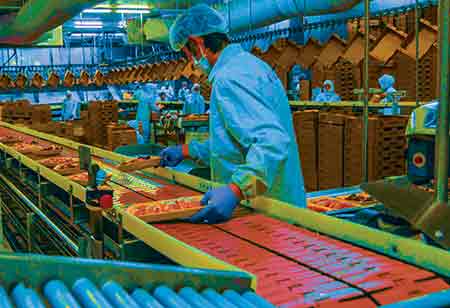Thank you for Subscribing to Food Business Review Weekly Brief
- Home
- Topics
- Alternative Proteins and Plant Based Food
- Beer and Wine
- Canned Beverages
- Coffee And Tea
- Food and Beverage Consulting
- Food and Beverage Financial Service
- Food And Beverages Marketing
- Food Distributors
- Food Ingredients
- Food Sustainability
- Plant Based Food and Beverages
- Seafood Suppliers
- Supplement Manufacturing
- Wine Investment
- News
- Vendor Viewpoint
- CXO Insights
- Conferences
- Newsletter
- CXO Awards
-
Confirming Food Safety with Big Data and IoT
Advanced IoT sensors, RFID, and bar codes are created to remove detailed information and track the shipped food items.

By
Food Business Review | Saturday, February 05, 2022
Stay ahead of the industry with exclusive feature stories on the top companies, expert insights and the latest news delivered straight to your inbox. Subscribe today.

Numerous ideas and applications to confirm the quality and safety of food products through Big Data and IoT are referred to below.
Tracing Shipment with IoT:
Advanced IoT sensors, RFID, and bar codes are created to remove detailed information and track the shipped food items. The functionality of the sensors can considerably increase food safety, identify even small dust specks, and monitor environmental conditions such as temperature. Sensors can also deliver real-time data, thus ensuring optimal conditions highlighted by safety guidelines.
IoT in Investigation:
IoT technology can oversee and conduct superior quality tracking and investigate the exact location of contamination.
Adding of Big Data:
With the aid of Big Data technology, IoT can analyze and assemble the data to recognize food-safety failures, assist in tracking failure points, and predict the reason for food spoilage.
Cultivators:
Recognition of natural disasters, with the support of Big Data from historical patterns analysis, can prevent food-related accidents and utilize products beneficially. However, certain environmental conditions cannot be encouraged because of the contamination of food products that will be branded unsafe for consumption.
Genetic Indexing:
Genetic Indexing can be conducted with Big Data technology as it distinguishes and understands the correlation between DNA and RNA. In addition, IoT can track the source of the bacteria that Big Data identifies.
Storage safety with Big Data and IoT:
Most food storage facilities face the same crisis—infestation with rats—that bring down the quality of the food product regardless of the source. Real-time data from the IoT sensors can monitor, control, and prevent any conditions that jeopardize the quality of food products.
Big Data and IoT promote better collaboration:
The collaboration between Big Data and IoT technologies helps maintain the quality of food products manufactured from harvesting to packaging. In addition, although human beings carry out the ultimate change, the technology can enable verification and identification systems to support the mitigation of risks associated with global food systems.
Implementing the collaborative technological framework can increase the development of the food industry and the economics behind it. The IoT and Big Data are integrated to attain answers for evaluating feasibility and risks associated with the spread.






